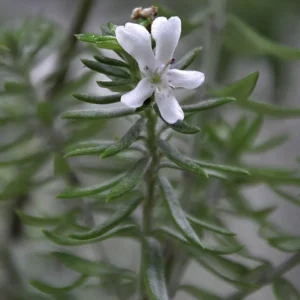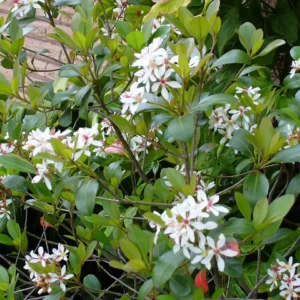Enrich Your Garden with Rosmarinus Officinalis
Rosmarinus officinalis is an evergreen shrub with pale blue flowers that bloom in spring and summer. It is a wonderful option for raised garden beds, containers, and in-ground gardens.
Apart from its aesthetic benefits, rosemary is popular for its culinary, medicinal, and cosmetic uses, making it a multi-purpose plant. Resilient and versatile, it will flourish with little effort whether you’re in a coastal region or an inland area.
How to Plant Rosmarinus Officinalis?
Planting this form of rosemary is easy, just as long as you follow these essentials steps:
- It’s typically ideal to start planting when the weather is mild. In this case, it is beneficial for rosemary to be planted in spring or early autumn.
- Location matters in gardening. When planting rosemary, pick a location with well-drained soil. Rosemary is not happy when waterlogged.
- Ensure it is planted in a spot where it’s likely to receive full sun as rosemary needs direct sunlight for around 6-8 hours daily. A sunny area in your garden or patio would be best.
- Use slightly alkaline soil. If heavy or the texture is clay-like, you can enhance drainage by mixing in gravel or coarse sand. To ensure great drainage, it’s also recommended to plant rosemary in raised beds or containers.
Why Should You Buy Rosmarinus Officinalis?
Popularly known as just rosemary, Rosmarinus officinalis is a top pick among gardeners. It’s visually stimulating and the benefits go beyond garden aesthetics. Here’s why this evergreen shrub that’s native to Mediterranean is an enduring choice in every garden:
- They’re Easy to Maintain: Preferring full sun, rosemary flourishes in moist, well-drained soil. Since it’s drought-tolerant, it doesn’t require extensive care and maintenance once established, making it suitable for Australia’s diverse climates.
- They’re Resilient: Rosemary can withstand a wide range of conditions, including drought and poor soils. It can also endure hot summers and mild winters, making it well-suited to the Australian climate. Both first-time and experienced gardeners will find rosemary’s resilience very convenient.
- Rosmarinus Officinalis Benefits: More than its ornamental value, the rosemary plant is easily favoured for its culinary uses, adding a distinctive flavour to a variety of dishes. And not only does it make food taste good, it’s also known to improve digestion. Other Rosmarinus officinalis benefits include antioxidant and anti-inflammatory properties from the rosemary extract (from fresh or dried leaves) that serve traditional medicinal purposes. The aromatherapeutic benefits of rosemary oil are also widely known, such as alleviating physical and mental fatigue.
- Enduring Beauty: Growing to a height of 1-2 metres, rosemary’s upright growth habit adds structure to any garden or landscape. The pale blue flowers, meanwhile, not only provide a relaxing fragrance, but also a soft contrast to the rich green foliage, particularly when in bloom.
How to Care for Rosmarinus Officinalis?
Once established, rosemary doesn’t require much maintenance, which is good news for novice gardeners. Here are some things to remember when caring for it.
- Once established, water deeply but not too often. This way, the soil can dry out between watering. This also makes more sense considering rosemary is drought-tolerant.
- Regular pruning is recommended to stimulate thicker growth. Pruning after flowering also encourages new growth and retains its healthy shape.
- While Rosemary flourishes without fertiliser, you can choose to use a slow-release fertiliser in spring to encourage healthy growth.
- Apply a light layer of organic mulch around the base to conserve moisture and suppress weeds, but avoid letting the mulch touch the stems to prevent rot.
- In cooler regions, protect rosemary from frost by covering it with a frost cloth or moving potted plants indoors.
Things to Consider When Growing Rosmarinus Officinalis
Growing rosemary has certain requirements that need to be met diligently, especially in the beginning. During planting, its primary requirement is well-drained soil, which means you need to make sure that the planting area has good drainage, otherwise excess water can just bring root rot to your plant.
The climate is another key factor knowing that rosemary prefers full sunlight. If you want your rosemary plant to thrive, you need to give it around 6 to 8 hours of direct sunlight. Rosemary is also not exempted to fungal diseases, however, air circulation can help prevent this. You just need to observe proper spacing between plants to achieve good air circulation.
Treating Your Rosmarinus Officinalis for Signs of Diseases and Pests
Keeping your plant healthy and thriving means you need to be proactive about potential diseases and pests plaguing your plants. That’s why it’s a good thing that rosemary is generally pest and disease-resistant, except for the occasional bouts of root rot because of overwatering and powdery mildew due to high humidity and poor air circulation.
Pests like aphids and spider mites can occasionally cause trouble for plants like rosemary, although you can prevent aphids by fostering natural predators in your garden like ladybugs. Spider mites, on the other hand, can be avoided by keeping the plant well-watered and ensuring humidity levels are moderate.
Where Can I Buy Rosemary?
At Local Botanist, we offer a variety of evergreen shrubs that include the top favourite rosemary or Rosmarinus officinalis, perfect for adding both flavour and fragrance to your garden. Plus, you’ll be bringing a touch of the great Mediterranean to your backyard, with the extra benefit of attracting pollinators and other beneficial insects.
From enhancing culinary dishes to creating your own essential oils to adding a touch of finesse to any space, Rosmarinus officinalis is a gorgeous and beneficial addition to your garden.
You can add it to your collection immediately when you buy Rosmarinus officinalis plants from Local Botanist. We deliver indoor and outdoor plants to the Gold Coast area, Northern NSW, Brisbane and Sunshine Coast. Check out our Plantastic Delivery section for more shipping information.
Rosmarinus Officinalis Companion Plants You Might Also Like
Considering its potential to bring you a gorgeous, aromatic garden with the rosemary essential oil known for its soothing properties, adding rosemary to your garden seems like a no-brainer.
To create a more dynamic garden, you can also pair rosemary with the following plants:
- Lavender: Both plants thrive in similar conditions and together create a visually and aromatically pleasing garden bed.
- Thyme: This low-growing herb pairs well with rosemary and shares similar soil and light preferences, making them perfect companions in a herb garden.
- Sage: Sage complements rosemary in both the garden and the kitchen, with both herbs thriving in full sun and well-drained soil.
- Oregano: Like rosemary, oregano is a hardy herb that prefers sunny, dry conditions, making them ideal companions in an Australian garden.
| Weight | 1.5-2 kg |
|---|---|
| Pot Size | 140mm |
Detailed Information
| Typical height | 1-2 metres |
|---|---|
| Minimum temperature tolerance | Can tolerate temperatures as low as -5°C |
| Climate | Thrives in warm, temperate regions |
| Light conditions | Full sun |
| Growth habit | Upright, with needle-like leaves and small, pale blue flowers |
| Growth conditions | Needs well-drained, sandy or loamy soil; drought-tolerant once established; prefers full sun |
Q: When is the best season to plant Rosmarinus officinalis in Australia?
Spring is the best season to plant rosemary as the soil is beginning to warm up, though it can also be planted up to early autumn when the weather is still mild. If you happen to plant it in summer, make sure to avoid hot spells and water regularly.
Q: What are the best Rosemary varieties for Australian gardens?
Popular varieties include ‘Tuscan Blue,’ known for its tall growth and vivid blue flowers, and ‘Prostratus,’ a trailing variety perfect for ground cover or hanging baskets.
Q: How fast does Rosemary grow in Australia?
In optimal conditions, rosemary can grow moderately fast, reaching its full height of 1-2 metres within 3-5 years, depending on the variety and growing conditions. In general, it doesn’t tolerate any shade, but can be tolerable when it has 4-6 hours of direct sunlight. However, such conditions can make it grow slower.
Q: Can I grow Rosemary in a pot?
Yes, rosemary is well-suited to container growing. Ensure the pot has good drainage and is placed in a sunny location. Regular watering is essential, but be careful not to overwater, as rosemary prefers drier conditions.
Q: Can I grow Rosemary indoors?
While rosmarinus officinalis generally prefers the full sun, it’s possible to grow rosemary indoors just as long as you observe optimal growing conditions, such as placing it at a kitchen windowsill with a southern exposure to get enough light and air.
It would help to rotate this ornamental plant on a weekly basis to ensure that all sides receive six to eight hours of direct sunlight.
Q: What are the benefits of Rosemary in the house?
Rosemary plants release beneficial compounds which contribute to cleansing the air in your home, hence, improving indoor air quality. Rosemary is also claimed to help reduce pain, improve memory and circulation, and even promote hair growth.
However, ingesting undiluted rosemary oil or large amounts of rosemary leaves is said to be unsafe. It’s also not recommended for people with certain medical conditions like high blood pressure.
Rosemary
Rosmarinus Officinalis
- In stock
- Delivery within 1-3 days based on location.
- Local pickup by appointment only
- Delivery Fees and Minimum Purchase
- *Unable to deliver to VIC due to mandatory inspection by Plant Standards Victoria for red imported fire ants.
Widely known as rosemary, Rosmarinus officinalis is a popular herb with needle-like dark, green leaves, pale blue flowers, and soothing, fragrant scent that thrive in warm and sunny climates. It is native to the Mediterranean region, however, its beauty, fragrance and variety of benefits and uses has made rosemary a staple in many gardens worldwide, including Australia.
Synonyms: Rosemary, Compass Plant, Polar Plant
Payment methods
Your payment information is processed securely. We do not store credit card details nor have access to your credit card information.








Reviews
There are no reviews yet.